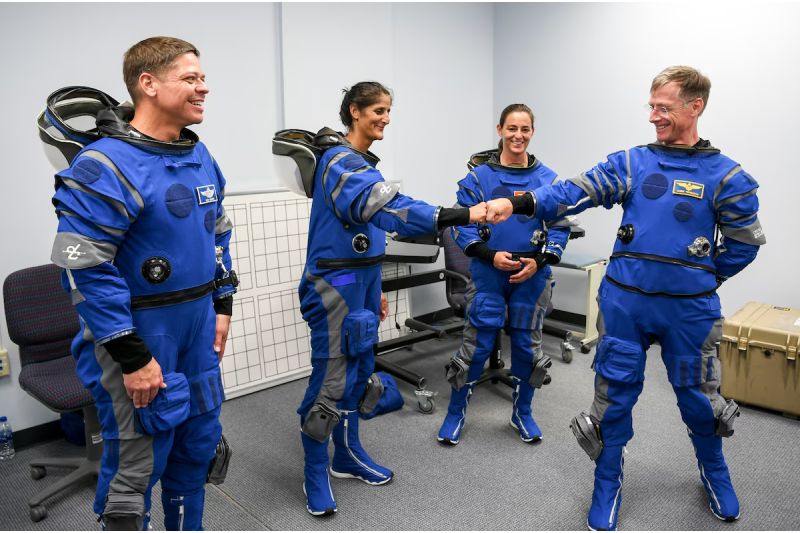In a news release from NASA, the agency said that on Tuesday, April 22, at NASA’s Johnson Space Center (JSC) in Houston, astronauts Barry “Butch” Wilmore and pilot Suni Williams, who would be flying on Boeing Starliner, entered the routine pre-flight quarantine.
As stated by NASA officials, quarantine will “ensure the health and safety of the crew prior to liftoff, as well as prevent sickness of the astronauts at the International Space Station.” “During quarantine, astronaut contact is limited, and most interactions are remote — although family and some launch team members also may be in quarantine or cleared before interacting with the crew.”
The Crew Flight Test, or CFT, mission of the astronauts will take off for space from NASA’s Kennedy Space Center (KSC), located close to Orlando, Florida. Additionally, the two will be the first people to travel on an Atlas V rocket operated by the United Launch Alliance (ULA).
NASA awarded contracts to Boeing and SpaceX in 2014 for commercial human flights to the International Space Station. NASA’s space shuttle routinely rotated ISS astronauts prior to commercial crew until the program’s retirement in 2011 following 30 years of operations.
SpaceX has a $2.6 billion commercial crew contract, while Boeing has a $4.2 billion contract for the Starliner. While Starliner was four years behind schedule, SpaceX has been using Crew Dragon to conduct operational ISS trips since 2020.
Many technical issues with Starliner were found and fixed by engineers, especially when the first unmanned test flight in 2019 did not succeed in reaching the International Space Station as scheduled. (In 2022, a second flight arrived safely.)
Further problems were discovered in 2023, which further delayed human spaceflight: for example, the suspension lines of Starliner’s main parachutes could support less weight than originally estimated by engineers, and a major portion of the capsule’s wiring was covered in combustible P213 tape.
Officials from Boeing and NASA stressed that the delays were required for safety. The crew is also optimistic that everything is prepared for the astronauts. If problems arise during flight, as is typical with new spacecraft, Starliner will be well taken care of: Former test pilots for the US Navy, Williams and Wilmore are experienced in ironing out the bugs.
Officials posted on X (previously Twitter) that on April 18, NASA’s commercial crew program given CFT the “go for launch” after a flight test readiness evaluation. On April 25, the day the astronauts are supposed to go to KSC for launch preparation, there will be another review.
On April 16, Starliner traveled six miles (10 km) via buildings at KSC to ULA’s vertical integration facility, where it was mounted onto an Atlas V rocket. Prior to the rocket rolling out to its KSC launch pad, engineers are checking the rocket’s communications with the ship.
At the latest, early 2025 is when Starliner-1, the spacecraft’s first operational voyage, is scheduled to launch. NASA’s Scott Tingle, NASA’s Mike Fincke, and the Canadian Space Agency’s Joshua Kutryk make up the crew for that mission.
Since the ISS’s construction started in 1998, Russia’s Soyuz spacecraft has been carrying humans there in addition to SpaceX and Boeing. There are NASA astronauts who fly on Soyuz for both policy and technical reasons.
NASA offers a number of quarantine rooms for astronauts and their support staff. According to general contractor Harvey Cleary, JSC’s NASA Astronaut Quarantine Facility is a 12,000-square-foot facility with 12 private sleeping quarters, as well as restrooms, a fitness center, and a full kitchen.
Situated on the third floor of the Neil Armstrong Operations and Checkout Building, KSC’s Astronaut Crew Quarters span approximately 26,000 square feet and are utilized for spacecraft testing and assembly. NASA officials listed the facility’s amenities, which include 23 bedrooms and bathrooms, a suit room for putting on spacesuits prior to launch, a kitchen, eating area, gym, conference rooms, laundry facilities, medical examination rooms, and a flight surgeon’s office.
